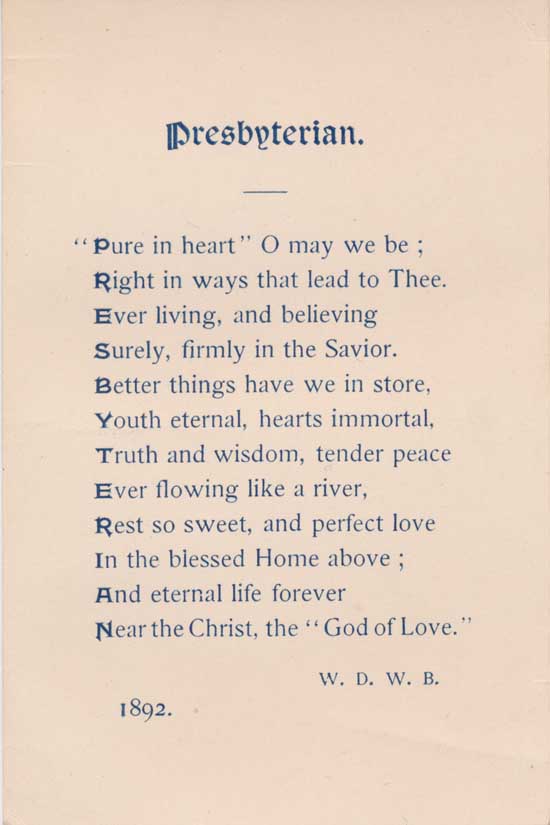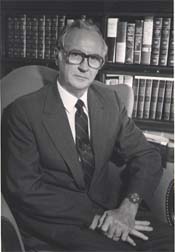![Leroy Tate Newman [1885-1969]](https://thisday.pcahistory.org/wp-content/uploads/2014/03/LTNewland.jpg) LeRoy Tate Newland was born in Galva, Iowa on 7 March 1885 to James Tate Newland and his wife, Fanny Rosalia Maria (Miller) Newland. He was educated at Davidson College, attending from 1904-1908 and graduating with the B.A. degree, before attending the Louisville Presbyterian Theological Seminary in preparation for ministry, 1908-1911.
LeRoy Tate Newland was born in Galva, Iowa on 7 March 1885 to James Tate Newland and his wife, Fanny Rosalia Maria (Miller) Newland. He was educated at Davidson College, attending from 1904-1908 and graduating with the B.A. degree, before attending the Louisville Presbyterian Theological Seminary in preparation for ministry, 1908-1911.
Following closely on the heels of graduation, he married Sarah Louise Andrews of Charlotte, North Carolina on 5 May 1911, and then pursued his examinations under the Presbytery of Wilmington. He was licensed to preach on 11 May and ordained to the ministry on 12 June of 1911. The young couple then took up a foreign missions post in Korea, where Rev. Newland served from 1911 until 1940.
His term of service in Korea was broken into basically three phases, serving in Kwangju from 1911-1914, then moving to Mokpo from 1914-1918 before returning to Kwangju and remaining there from 1918 until the end of his missions work in 1940. In 1926, perhaps while on home missions assignment, Rev. Newland earned the Th.M. degree from Union Theological Seminary in Richmond, VA. It was during those years on the mission field that the Newland family grew to include seven children.
With war looming, Rev. Newland and his family children returned to the United States, and he answered a call to serve a group of smaller churches in and near Union Point, Georgia, from 1941 until 1954. Rev. Newland then took a call to serve as the pastor of the Rumple Memorial Presbyterian Church in Blowing Rock, North Carolina, laboring there from 1954-1957 before being entered on the rolls as honorably retired in 1957. In retirement, Dr. Newland was active in working with the Presbyterian Evangelistic Fellowship, a ministry headed up by the Rev. William E. Hill, Jr.. His reward at hand, LeRoy Tate Newland entered glory on 16 July 1969.
Among his distinctions and honors, Davidson College conferred the degree of Doctor of Divinity in 1933. Dr. Newland also authored at least two published works during his lifetime, both of which are noted by Harold B. Prince in A Presbyterian Bibliography: #2482 (p. 240), So Rich a Crown: Poems of Faith (Atlanta, GA: Gate City Printing Co., 1963), 85 p. and #2483 (p. 241), Illth or Wealth?: A Series of Four Bible Studies for the Men of the Presbyterian Church, U.S. (Chattanooga, TN: General Assembly’s Stewardship Committee, Presbyterian Church in the U.S., 1924), 48 p. Davidson College holds one copy of the former title and the Union Theological Seminary in Richmond, VA holds a copy of the second work.
Memorial Tribute by Sarah Bolton Lunceford, one of Rev. Newland’s daughters:
LeRoy Tate Newland, missionary to Korea, father of seven, man of many gifts, was born in Galva, Iowa, on March 7, 1885. His family moved back to North Carolina, to Chadbourne, where his father had a strawberry farm. James Newland made an unusual offer to each of his sons: a part of the farm or higher education. Roy Newland made his choice, and went on to graduate from Davidson, from Louisville Seminary, and to get his master’s from Princeton Seminary. His honorary doctorate was bestowed by Davidson.
In 1911, he married Sarah Louise Andrews of Charlotte, and the two went out as missionaries to Korea. She was 20, the youngest missionary in the field. He, as an evangelist, worked under the itinerating system: long journeys, lasting several weeks, exploring the Korean countryside out from Kwangju, their home station, establishing small house churches, to be visited again and nurtured. Eventually, he had set up over a hundred and twenty.
Because of his unassuming competence and dependability he became treasurer and secretary for the mission — the Southern Presbyterian compounds and work in South Korea. His sermons were admired for their content and his presentation of them. His commentary on Leviticus was used for years in the seminary at Seoul.
His children delighted in his company because of his simple, direct love and his pleasure in good humor and bad puns. Among their most cherished memories are summer days in the mountain cabin when he would read aloud Slappey and Glencannon stories from The Saturday Evening Post, with his reading getting ahead of his voice so that he was too convulsed with laughter to share the passage with his imploring audience. Then there were the long walks when he would name the plants and answer all the questions asked by seven lively children. There were the rousing family hymn-sings which he led with such enthusiasm even if not necessarily on key. And the “Dear Family” letters he so faithfully wrote over the years, sharing the news and his tender love, extracting a promise that letters would continue to bind the family even after he was gone.
One of Roy Newland’s gifts was a love for and facility with poetry. He wrote hundreds of poems —an original one for every birthday of every child and the wife he adored; one for her every morning that he made her breakfast and carried it in to her on a tray; frequently, in later years. He wrote about his struggles, about the work, about his unworthiness and Christ’s great love that had redeemed him. A collection of his poems was published, but it barely sampled the outpouring.
True to his background, he loved to garden, to hike, and to hunt, the latter a special pleasure in a country where weapons were forbidden so that game multiplied unchecked. (His permit came from Tokyo itself and was the occasion of frequent visits from suspicious Japanese inspectors.) He also loved to read, to learn, to explore the frontiers of knowledge. His probing mind wanted to know how the world worked, in all its fascinating aspects.
Gifted in mind, intellect, and soul, LeRoy Tate Newland was a man of parts. He was, truly, in the words of an English friend, “a lovely man.”


![Leroy Tate Newman [1885-1969]](https://thisday.pcahistory.org/wp-content/uploads/2014/03/LTNewland.jpg)
